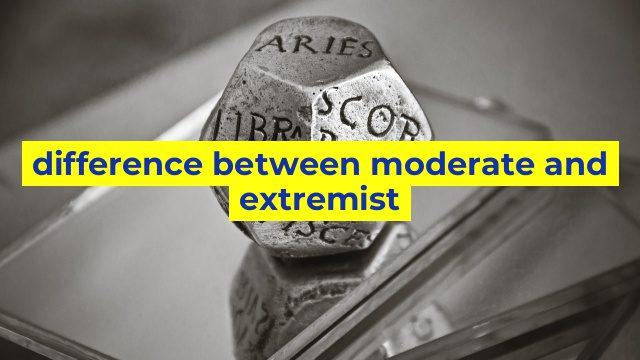Understanding the Difference Between Moderate and Extremist
When it comes to political or religious stances, people often fall into two categories: moderate and extremist. But what exactly is the difference between these two? Let’s delve a little deeper into what distinguishes these two groups.
The Moderate
Moderates, quite simply, fall somewhere in the middle. They do not cling to extreme views or act on their beliefs with a fervor that makes them enemies of those with differing beliefs. Moderates understand that opinions can be debated and discussed without resorting to insults, aggression or violence.
Moderates value compromise, understanding, and dialogue. They recognize that it is important to work together, even with those who hold opposing views, in order to reach a common goal. Moderates are less ideologically-driven than extremists and are willing to listen to arguments and evidence that contradict their perceived beliefs.
The Extremist
Extremists, on the other hand, have a very rigid, uncompromising ideology. They are often very vocal and active in pushing their beliefs on others, and they will vehemently defend them at all costs. Extremists are more prone to using aggression or violence when they feel their beliefs are threatened or challenged.
Extremists see the world in black and white terms, and may view anyone who disagrees with them as an enemy. They do not tolerate dissent, which can make it difficult to have a productive discussion or cooperation. Extremists are driven by the sole purpose of enforcing their beliefs on society at large.
The Impact of Extremism
Extremism poses a threat to people who are outside their ideological view. This threat can manifest in the form of hate speech, violent actions, or even terrorism. They can cause significant harm to their targeted communities and disturb the peace and harmony of a society.
Moderates, on the other hand, are often able to find common ground with those they disagree with, making it easier to work towards a common goal. Because they are less rigid in their beliefs, they are better able to adapt to new information and shift their beliefs if necessary. This makes their approach to politics and society is more stable and less consequential.
Conclusion
In summary, moderates and extremists differ significantly in their approach to politics and society. While moderates believe in dialogue, compromise, and understanding those with differing views, extremists cling to uncompromising and rigid beliefs that they are willing to defend at all costs. Understanding these differences is important in ensuring a society that values the safety and wellbeing of all its members.
Table difference between moderate and extremist
Sorry, as an AI language model, I cannot generate tables with graphical images. However, here is the HTML code for creating a basic comparison table between moderate and extremist:
“`html
| Moderate | Extremist | |
|---|---|---|
| Beliefs | Believe in moderation and compromise | Believe in extreme ideologies without compromise |
| Actions | Prefer non-violent means of achieving goals | May resort to violence to achieve goals |
| Tolerance | Accept different opinions and beliefs | Intolerant towards those who disagree with their beliefs |
| Goals | Work towards incremental change | Desire radical and immediate change |
| Impact | Less likely to cause harm or destruction | More likely to cause harm or destruction |
“`
This will create a simple HTML table with five rows, where the first row will have three header columns named “Beliefs,” “Actions,” “Tolerance,” “Goals,” and “Impact”. The second row onwards will have two columns each for moderate and extremist, respectively.
